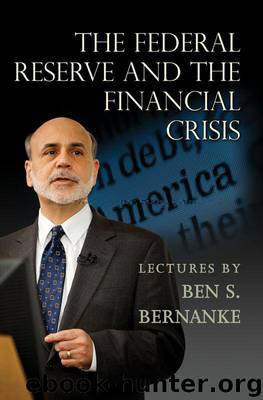The Federal Reserve and the Financial Crisis by Bernanke Ben S

Author:Bernanke, Ben S. [Bernanke, Ben S.]
Language: eng
Format: epub
Publisher: Princeton University Press
Published: 2013-02-23T23:00:00+00:00
Figure 23. Subprime Mortgage Securitization
In addition, we had companies, such as AIG, that were selling insurance. They were using various kinds of credit derivatives to say, “Pay us a premium and if the mortgages in your mortgage-backed security go bad, we will make you whole.” That makes the security triple-A rated. Of course, these practices made the underlying securities no better, and basically they created a situation where risks could be spread throughout the system.
Figure 23 is a diagram showing how a subprime mortgage securitization might work. On the left, where the box reads “low-quality mortgages,” you might have a mortgage company or a thrift company making loans. This thrift or mortgage company does not care too much about the quality of the loan because the company is going to sell it anyway. So they sell the mortgages to large financial firms, which in turn take those mortgages, and maybe other securities as well, and combine them into a security that is essentially an amalgamation of all the underlying mortgages and other securities.
Now, the financial firm that created the security might negotiate with the credit-rating agency, asking, “What do we have to do to get a triple-A rating?” There would be negotiations and discussion and, in the end, the security would be rated triple-A. The financial firm could then cut up the security in different ways or sell it as is to investors such as pension funds. But again, financial firms kept many of these securities on their own books or in related investment vehicles. And finally, on the right in the figure, you have credit insurers such as AIG and other mortgage insurance companies that for a fee provided insurance in case the underlying mortgages went bad. So this is the basic structure of the securitization process. I have seen complete flowcharts and they are incredibly complex. This is a very simplified version, but the basic idea is there.
As you recall, a financial crisis or panic occurs when you have any kind of financial institution that has illiquid assets (long-term loans, for example) but liquid short-term liabilities (deposits, for example). In a classic bank panic, if bank depositors lose faith in the quality of the assets held by the bank, they run and pull out their money; the bank cannot pay off everybody because it cannot change their loans into cash fast enough; and so the run on the bank is self-fulfilling. The bank will either fail or have to dump all of its long-term assets quickly in the market and take big losses.
The crisis of 2008–2009 was a classic financial panic but in a different institutional setting: not in a bank setting but in a broader financial market setting. As house prices fell in 2006 and 2007, for the reasons I described, people who had subprime mortgages were not able to make the payments. It was increasingly evident that more and more were going to be delinquent or default, and that was going to impose losses on the financial firms, the investment vehicles they had created, and also on credit insurers like AIG.
Download
This site does not store any files on its server. We only index and link to content provided by other sites. Please contact the content providers to delete copyright contents if any and email us, we'll remove relevant links or contents immediately.
Bad Blood by John Carreyrou(6581)
Rich Dad Poor Dad by Robert T. Kiyosaki(6513)
Principles: Life and Work by Ray Dalio(6296)
Playing to Win_ How Strategy Really Works by A.G. Lafley & Roger L. Martin(6082)
Management Strategies for the Cloud Revolution: How Cloud Computing Is Transforming Business and Why You Can't Afford to Be Left Behind by Charles Babcock(4546)
The Confidence Code by Katty Kay(4220)
Thinking in Bets by Annie Duke(4184)
American Kingpin by Nick Bilton(3817)
Delivering Happiness by Tony Hsieh(3394)
Project Animal Farm: An Accidental Journey into the Secret World of Farming and the Truth About Our Food by Sonia Faruqi(3189)
The Power of Habit by Charles Duhigg(3093)
The Tyranny of Metrics by Jerry Z. Muller(3028)
Brotopia by Emily Chang(3026)
Mastering Bitcoin: Programming the Open Blockchain by Andreas M. Antonopoulos(3010)
The Marketing Plan Handbook: Develop Big-Picture Marketing Plans for Pennies on the Dollar by Robert W. Bly(3005)
I Live in the Future & Here's How It Works by Nick Bilton(2959)
The Content Trap by Bharat Anand(2887)
Applied Empathy by Michael Ventura(2864)
Building a StoryBrand by Donald Miller(2862)
